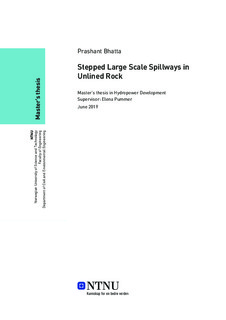| dc.description.abstract | Water is an imperative source to human life. The change in climate is affecting the availability of water round the year which combined with increasing water demand has become a global problem. This has rendered water storage as the only option for proper management of water. Construction of dams for the storage helps in the field of, flood control, navigation, power generation, irrigation, drinking water, and recreation. The inability to store all the water in the river streams economically while also maintaining a high level of safety, leads to the problem of conveying the excess water safely to the downstream. Construction of steps on spillway chute, construction of plane chute with stilling basins, flip bucket structures with plunge pool, and construction of energy dissipators like Roberts splitters and baffle blocks are some of the adopted methods for dissipating the energy of the flowing water.
Stepped spillways are efficient at dissipating the flow energy as the water flows down the steps. This design method has been adopted for a long time for its easy to build design, structural stability provided and the energy dissipation ability. In this study, the energy dissipation capability of the stepped spillway was tested in a physical hydraulic model. The effect of discharge rate, step dimension, and surface roughness on the energy dissipation rate has been tested. In addition, the change in energy dissipation with a change in spillway height has been studied. Furthermore, the viability of constructing stepped spillway in an unlined rock has been looked briefly.
The results obtained show a high energy dissipation efficiency for all the steps tested with the dissipation efficiency reaching as high as 93% for a low flow rate. For a constant step height to length ratio and for the same discharge, the dissipation efficiency was found to be higher for the bigger steps. Introduction of surface roughness further improved the dissipation efficiency. The construction of a weir on the steps to create pool of water was found to increase the dissipation efficiency considerably. Dissipation was considerably high for low discharges for which fully developed hydraulic jump was created for the falling jet. An inverse pattern between the discharge and energy dissipation was observed in the test. | |
